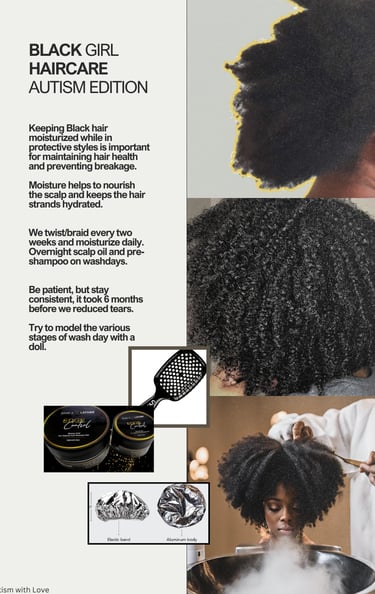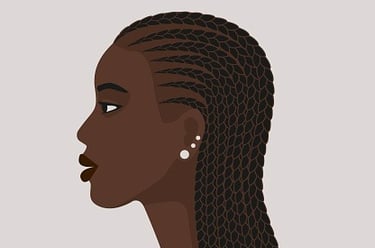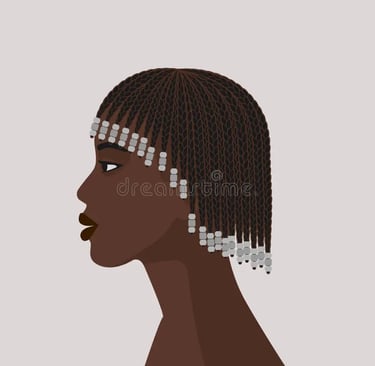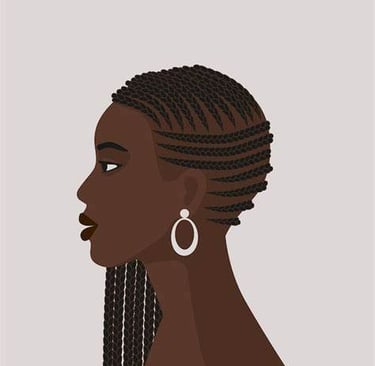Natural Hair Care Help: Reducing Pain and Sensory Overload
Autism & Black Hair Care | Sensory-Friendly Tips Keeping Black hair moisturized in protective styles is essential for healthy strands and preventing breakage. This guide shares tips on maintaining hydration, reducing tears during wash days, and creating a sensory-friendly routine for autistic individuals.
BLACK HAIRCARE
2/12/20252 min read


Understanding Sensory Input
Tender-headedness isn’t just about pain—it can be a sensory processing issue where the scalp is more sensitive to touch, pulling and product application. Children with autism may have heightened responses to these sensations, making haircare an overstimulating experience. That includes parting the hair, I've found that certain parts of the head can be more sensitive than others, pay close attention to the triggers.
Tips to Reduce Pain During Haircare
1. Keep Hair Moisturized
Dry hair is more prone to tangling and breakage, leading to painful detangling sessions. Keep the hair hydrated with leave-in conditioners, moisturizing sprays, and lightweight oils. Applying a detangling spray before combing can help reduce friction and ease knots.
Opt for wide-tooth combs, detangling brushes, or even finger detangling to reduce pulling. Brushes with flexible bristles designed for 4c hair distribute tension more evenly, making detangling less painful.
Working in small sections prevents overwhelming the child with too much pulling at once. Hold the section firmly near the root while detangling the ends first, then work upward to avoid tugging on the scalp.
4. Apply Warmth to Relax the Scalp
A warm towel or heat cap can soften the hair and make the scalp feel more relaxed before styling. This method is particularly helpful before detangling or braiding sessions.
5. Choose Protective Styles Wisely
Styles like braids and twists help reduce daily manipulation, but they should not be too tight. Loose, tension-free styles like chunky twists or buns can keep hair managed without discomfort.
Many children with autism benefit from sensory tools that help them stay calm during haircare routines. Here are some effective strategies that I have used or witnessed.
1. Provide Deep Pressure Input
Weighted lap pads or compression vests can provide calming deep pressure, helping children feel secure while their hair is being handled.
2. Ear Covers
If the sounds of detangling, running water, or product application are overwhelming, using ear cover can help. Some families have stuffed the covers with foam for extra sound proofing.
Giving a child a fidget toy to hold can help redirect their focus away from the haircare process and onto something comforting.
4. Model the Routine with a Doll
Using a doll to demonstrate the different steps of haircare before starting on the child’s hair can ease anxiety and make the process feel more predictable.
5. Encourage Deep Breathing and Breaks
Taking short breaks between steps allows the child to reset and avoid feeling overwhelmed. Practicing deep breathing together can also help regulate emotions.
With patience, gentle techniques, and sensory accommodations, haircare can become a more pleasant experience for tender-headed children. By focusing on moisture, using pain-free tools, and incorporating sensory aids, caregivers can help make wash days stress-free and even enjoyable. Every child deserves to feel comfortable and confident in their natural hair journey!
For many Black children with autism or sensory sensitivities, haircare routines can be overwhelming. Tender-headedness—when the scalp is highly sensitive—can make simple tasks like detangling, trimming, or braiding a painful experience. Also, sensations around the ear and vibrations that can be felt in the mouth are all inputs that many do not consider. However, with the right techniques, products, and sensory aids, haircare can become a more comfortable and even enjoyable experience.





